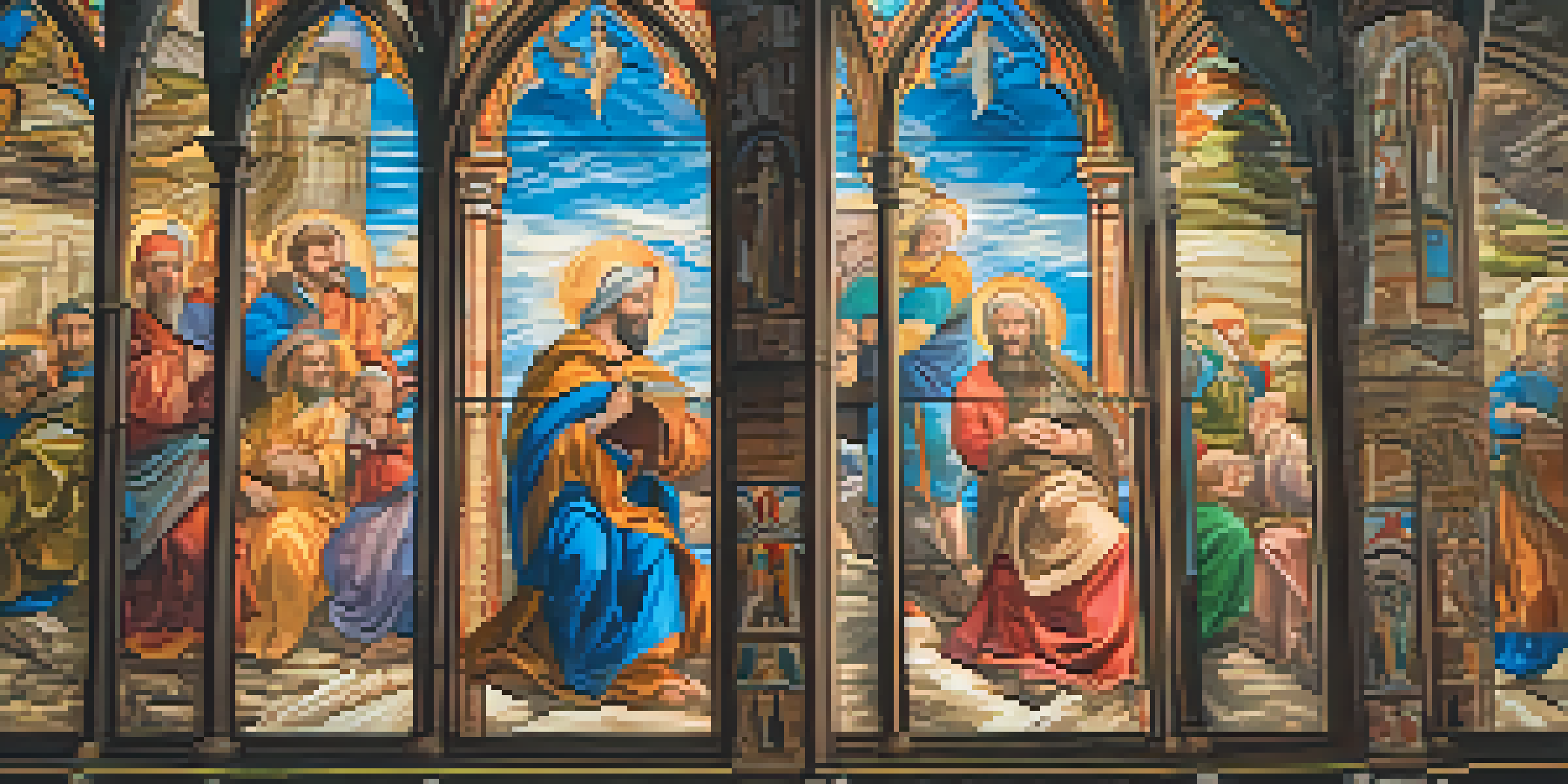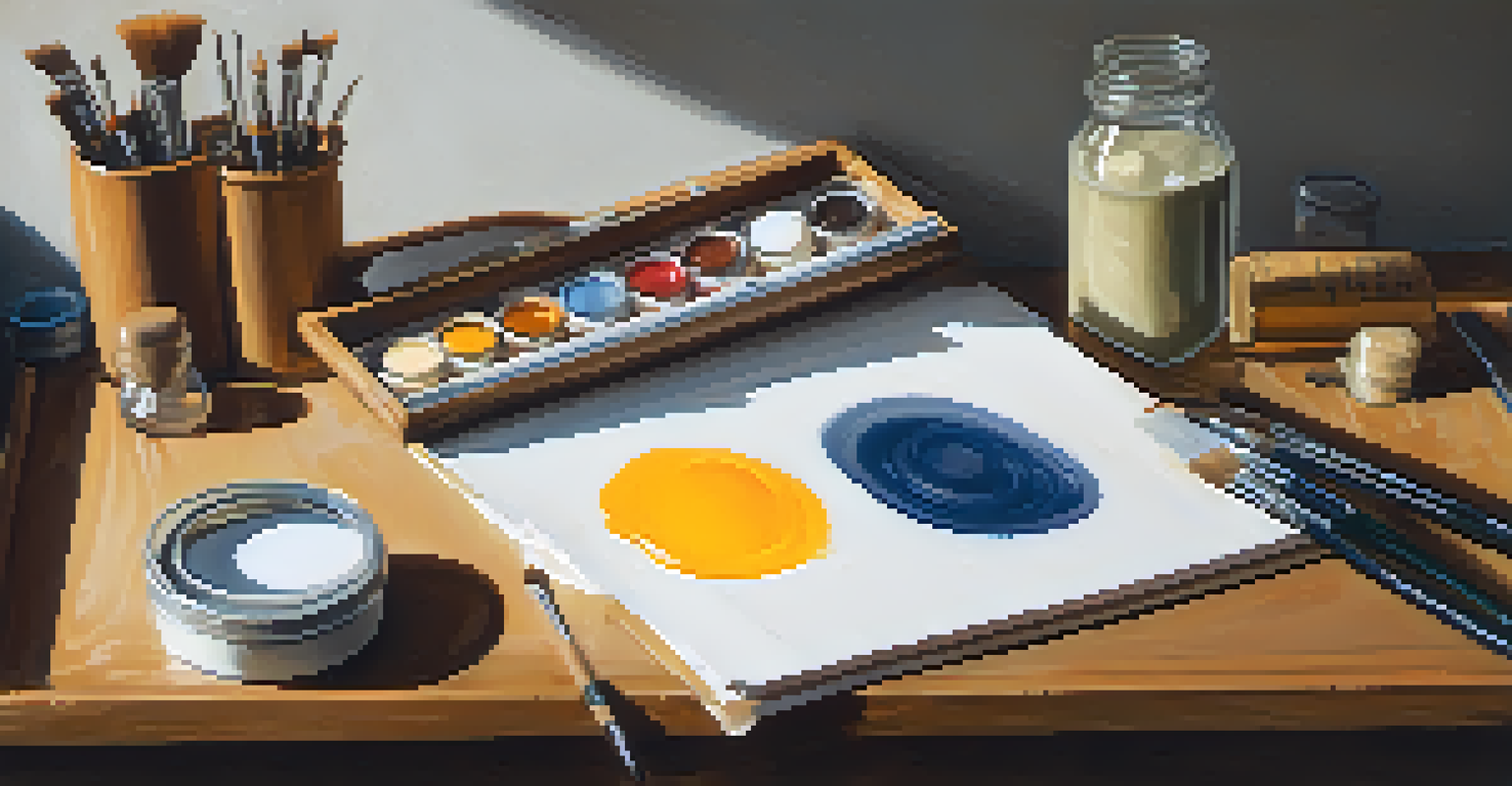Fresco vs. Tempera: Comparing Historical Painting Methods

Understanding Fresco: A Vibrant Wall Art Technique
Fresco is a method of mural painting that involves applying water-based pigments on freshly laid wet plaster. This technique allows the colors to bond with the wall, creating a durable and vibrant finish. When the plaster dries, it encapsulates the pigments, making the artwork an integral part of the wall itself.
Art is the most beautiful of all lies.
One of the most famous examples of fresco painting is Michelangelo's Sistine Chapel ceiling, where the colors have remained remarkably vibrant for centuries. The nature of fresco painting requires speed and skill, as the artist must work quickly before the plaster sets. This urgency often leads to dynamic and expressive compositions that are full of life.
Frescoes are typically found in grand public buildings and churches, often depicting religious scenes or historical narratives. The method's durability makes it a popular choice for large-scale artworks that are meant to inspire and impress visitors for generations.
The Basics of Tempera: A Delicate Paint Medium
Tempera is a painting medium made by mixing colored pigments with a water-soluble binder, commonly egg yolk. This combination creates a fast-drying paint that is known for its rich colors and fine details. Unlike fresco, tempera is applied to a dry surface, allowing for more controlled brushwork and layering.

One of the key features of tempera is its ability to create smooth, luminous finishes, making it ideal for detailed work, such as in portraits or small-scale religious icons. Artists like Botticelli and Duccio have famously used tempera to achieve stunning effects in their masterpieces. The medium requires patience and precision, as each layer must dry before additional layers are applied.
Fresco: Vibrant Wall Art Technique
Fresco painting involves applying pigments on wet plaster, resulting in a durable and integrated mural that showcases rich colors.
Tempera has a long history, dating back to ancient Egypt and Greece, and was widely used during the Renaissance. While it may not have the same scale as fresco, its versatility and the beauty of its finish have kept it relevant in the art world for centuries.
Materials Used in Fresco and Tempera Techniques
Fresco requires specific materials, including fine pigments, water, and a suitable plaster. The plaster must be applied while still wet, which means the artist must work rapidly to complete the painting before the plaster dries. The choice of pigments also plays a crucial role, as some colors react differently to the alkaline nature of wet plaster.
Every artist dips his brush in his own soul, and paints his own nature into his pictures.
In contrast, tempera utilizes a more straightforward set of materials: pigments and a binder like egg yolk or gum Arabic. This simplicity allows artists to experiment with a wider range of substrates, such as wood panels or canvas. The flexibility in materials makes tempera accessible for various projects, from small sketches to detailed paintings.
While both techniques rely on quality pigments, the methods of application and the surfaces they use create distinct final products. This variation in materials and techniques contributes to the unique characteristics of each painting method.
Techniques and Application: Fresco vs. Tempera
The application techniques in fresco painting involve a process known as 'buon fresco,' where pigments are applied to the wet plaster, and 'fresco secco,' which uses dry plaster. The former results in vibrant colors, while the latter can lead to less durable finishes as the paint sits on top of the plaster. The artist's skill in managing these techniques significantly influences the artwork's longevity and appearance.
Tempera painting, on the other hand, allows for layering and blending, giving artists greater control over their work. They can build up colors gradually, achieving depth and texture that would be challenging in fresco. This method encourages meticulous attention to detail, allowing for fine lines and intricate patterns that showcase the artist's precision.
Tempera: A Historical Painting Medium
Tempera, made from pigments and a binder like egg yolk, offers detailed and luminous finishes, making it a versatile choice throughout art history.
While both techniques have their unique applications, the choice between fresco and tempera often depends on the desired outcome and the artist's preferred style. Each method offers its own set of challenges and rewards, making them fascinating subjects for exploration.
Historical Context of Fresco Painting
Fresco painting has its roots in ancient civilizations, with notable examples found in Greco-Roman architecture. The technique flourished during the Renaissance, when artists like Giotto and Raphael revolutionized its use, creating stunning narratives on church walls that captivated viewers. This historical context highlights how frescoes were not just art but also storytelling devices.
As the Renaissance progressed, frescoes became a symbol of cultural achievement, reflecting the values and aesthetics of the time. Artists often collaborated with architects to design harmonious spaces where the artwork complemented the architecture. This synergy between art and structure is evident in many of the great cathedrals and public buildings throughout Europe.
Fresco painting's historical significance is not just in its aesthetic appeal but also in its role in shaping religious and cultural identity. It served as a visual representation of beliefs and ideals, making it an essential part of the artistic heritage that continues to influence artists today.
The Evolution of Tempera Through the Ages
Tempera has a rich history that dates back to ancient Egypt, where it was used for painting on papyrus and wood. The technique evolved over time, with the Renaissance marking its peak as artists explored its potential for fine detail and color richness. The use of egg yolk as a binder became particularly prevalent, allowing for vibrant and long-lasting colors.
During the Renaissance, tempera was often used alongside oil paints, providing a unique combination of techniques that enhanced the overall effect of the artwork. Artists like Leonardo da Vinci and Raphael incorporated tempera in their early works, showcasing its ability to create intricate details and soft transitions between colors.
Legacy of Fresco and Tempera
Both fresco and tempera have profoundly influenced modern art, inspiring artists to explore their techniques while connecting with historical traditions.
Today, tempera continues to be appreciated for its versatility and historical significance. Modern artists often experiment with this medium, blending traditional methods with contemporary themes, keeping the spirit of tempera alive while exploring new creative avenues.
Fresco and Tempera: Legacy and Influence on Modern Art
Both fresco and tempera have left lasting legacies that influence contemporary art. Fresco's grand scale and architectural integration continue to inspire muralists and street artists, who often seek to create site-specific works that resonate with their environments. The technique's emphasis on community and public engagement remains relevant in today's art scene.
On the other hand, tempera's precision and vibrant colors appeal to many modern artists, particularly those interested in detail-oriented work. The technique's adaptability allows for exploration in various contexts, from fine art to mixed media. Many artists appreciate the historical roots of tempera, using it as a way to connect with past traditions while pushing creative boundaries.

Ultimately, the enduring appeal of both fresco and tempera speaks to their fundamental roles in artistic expression. They remind us of the power of art to communicate ideas, emotions, and cultural narratives, bridging the gap between history and modern creativity.